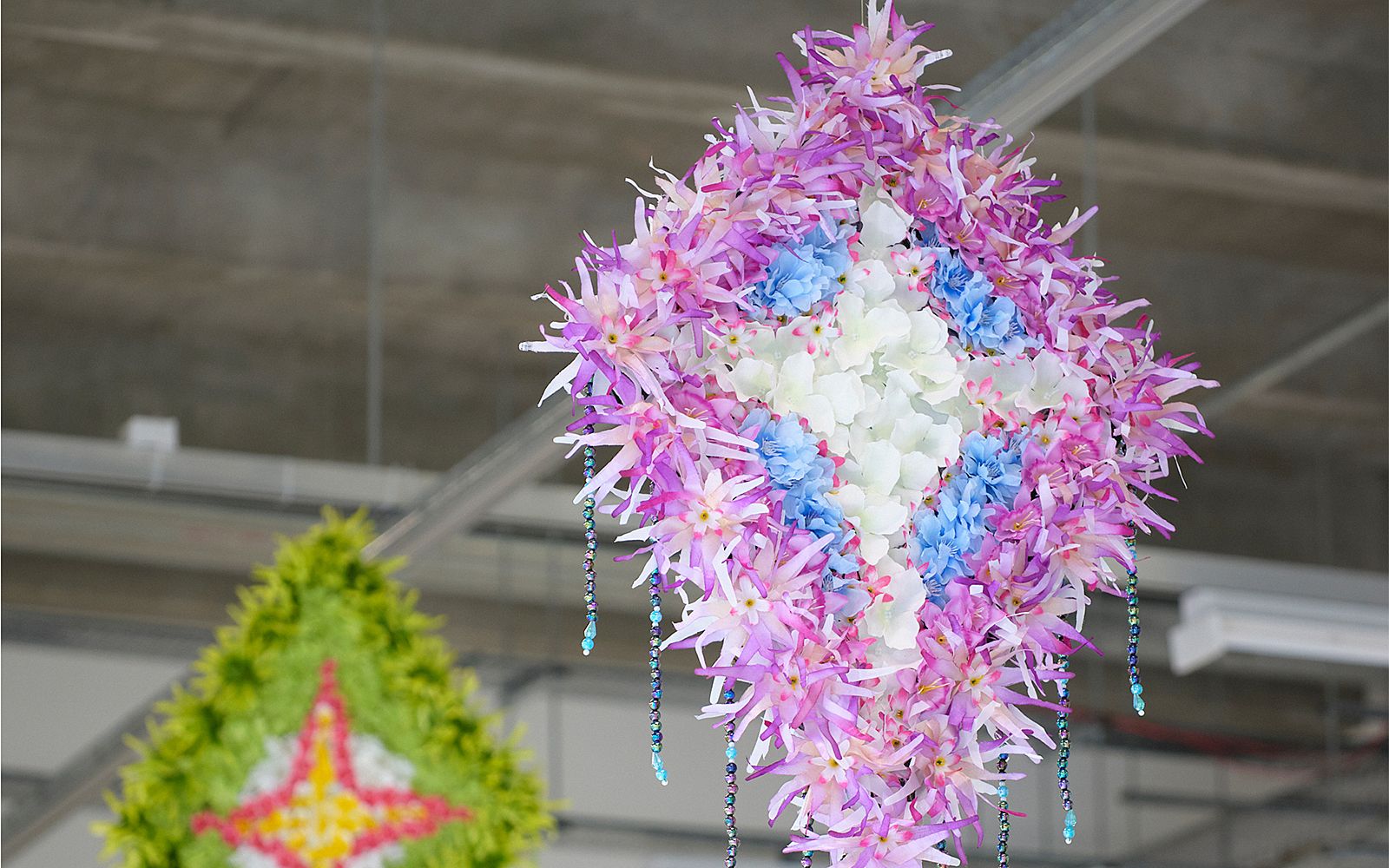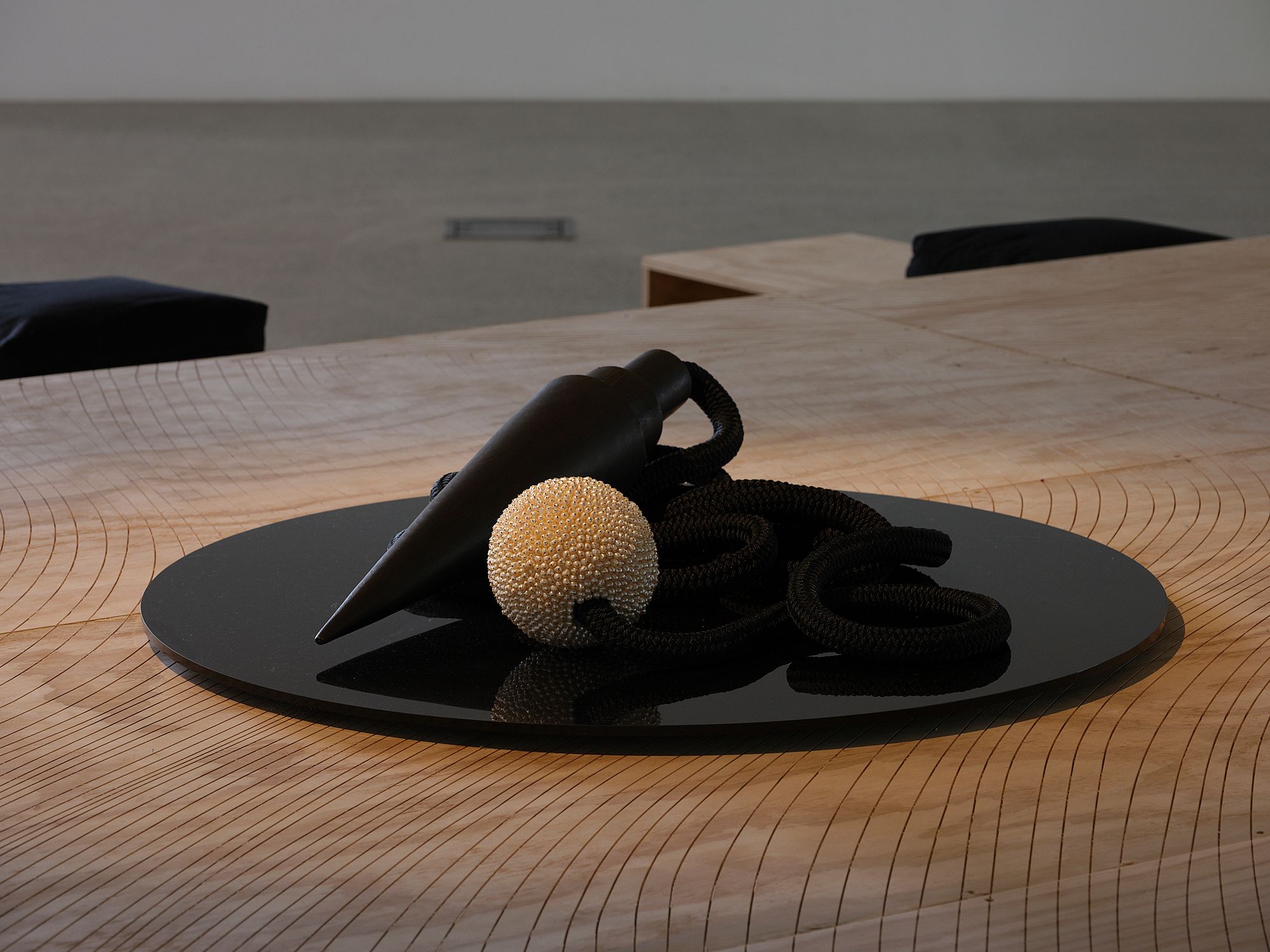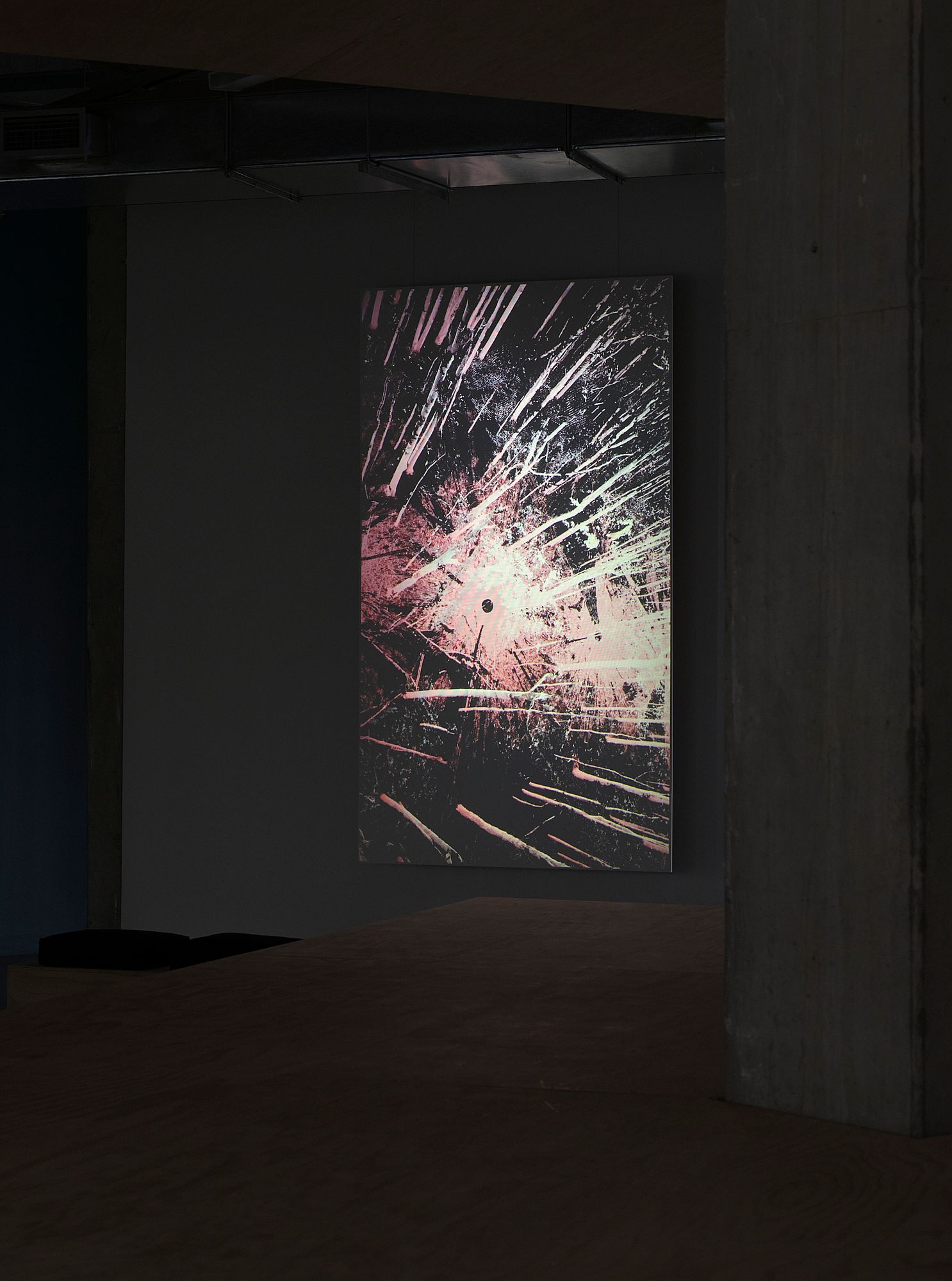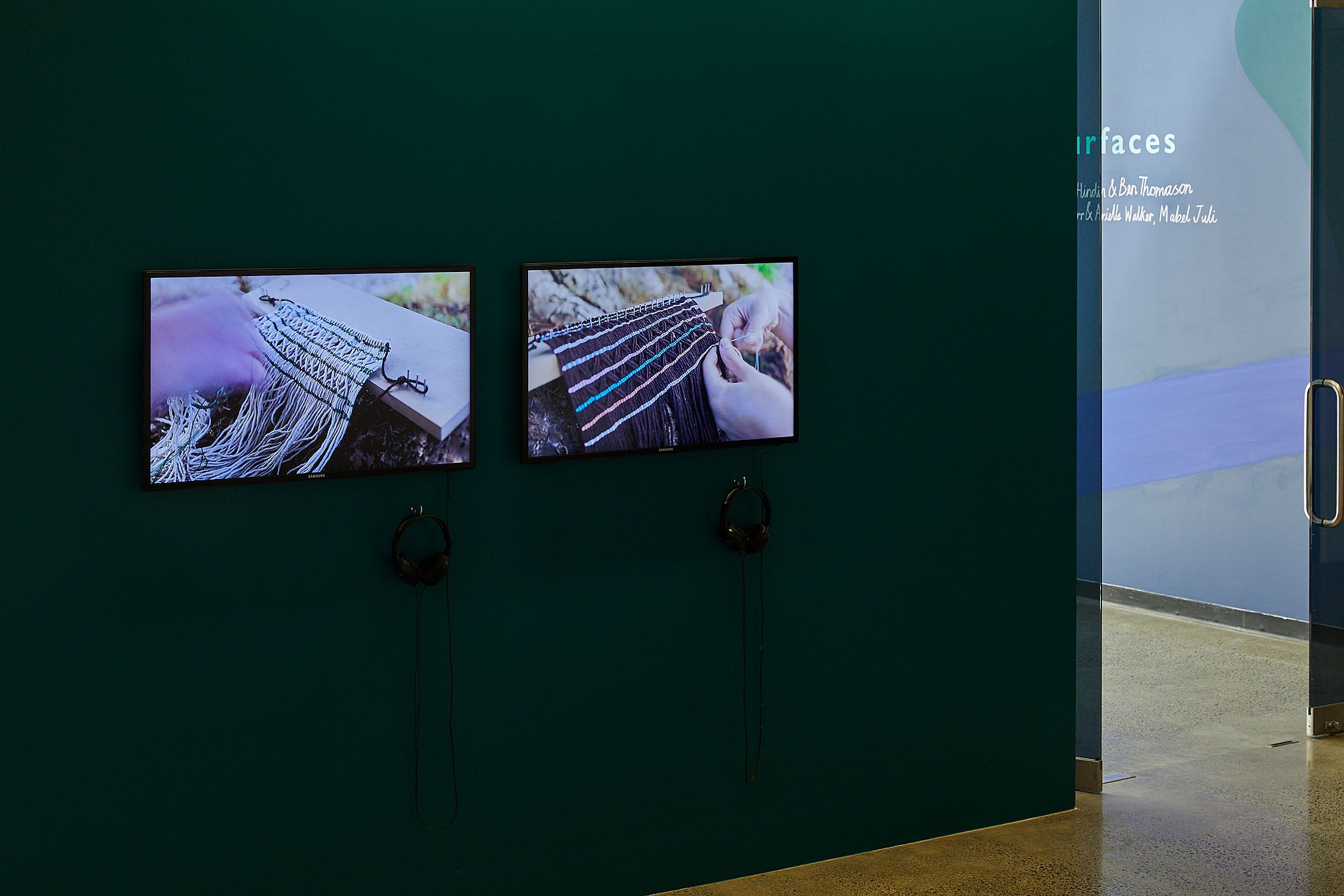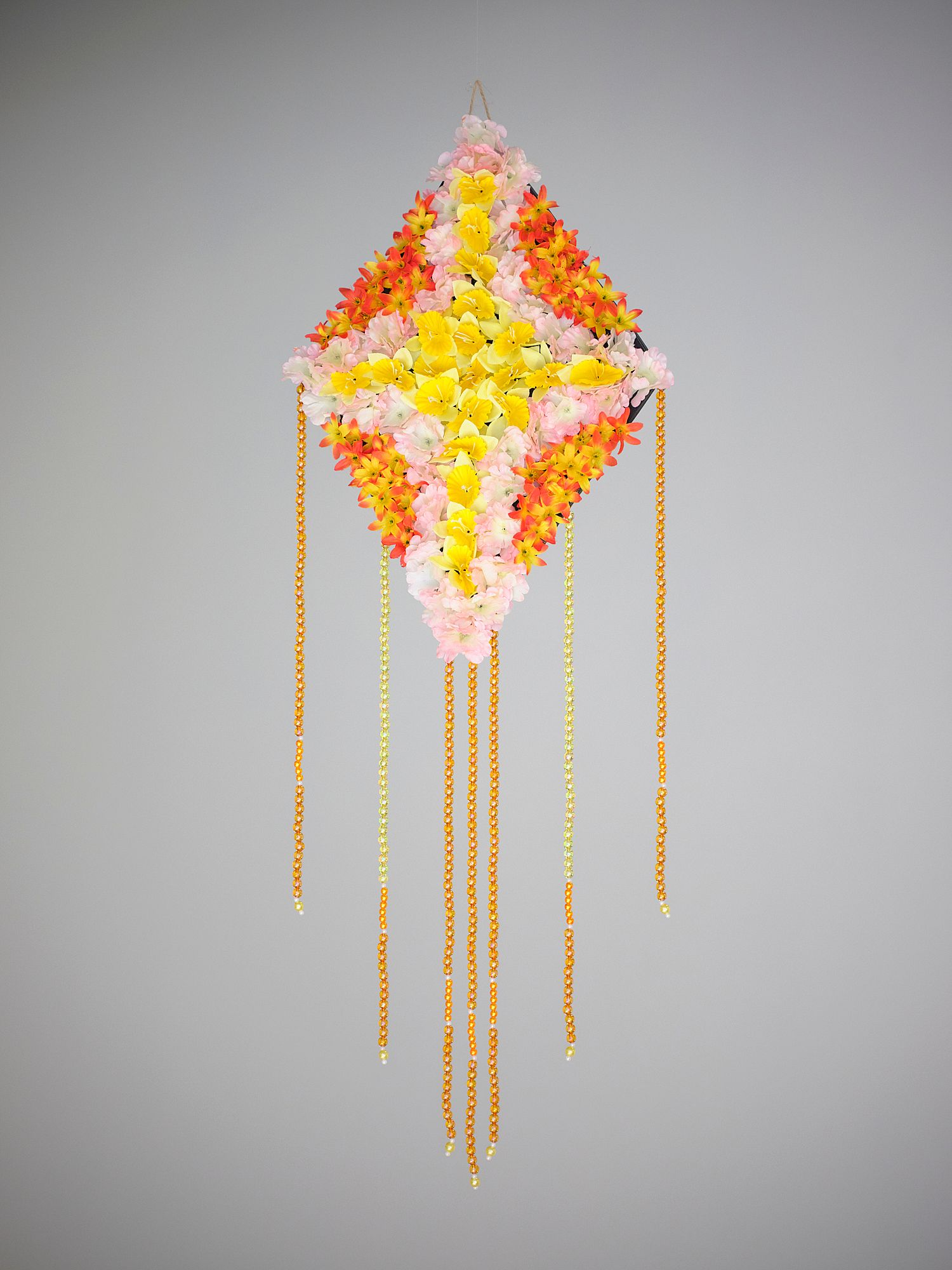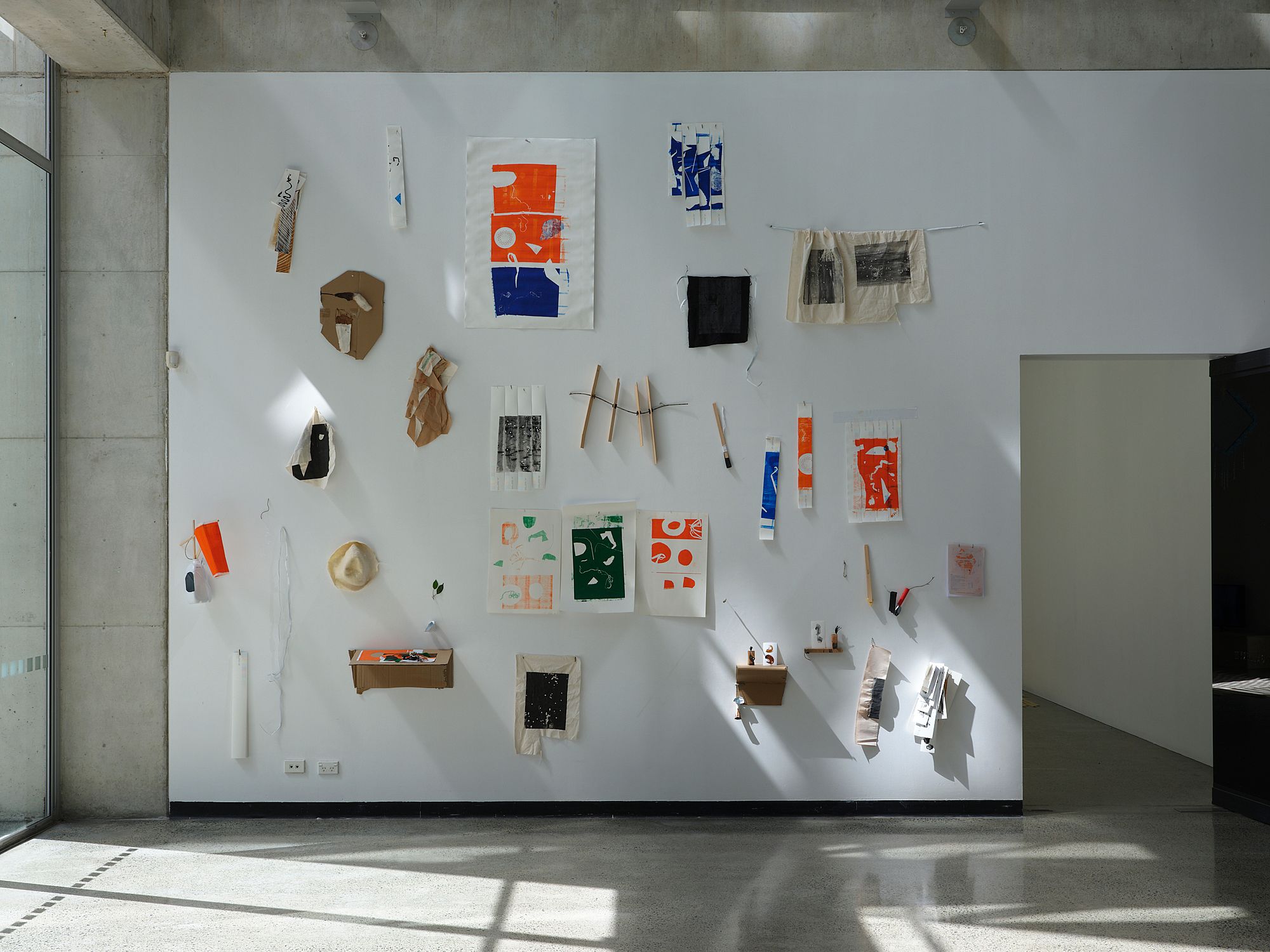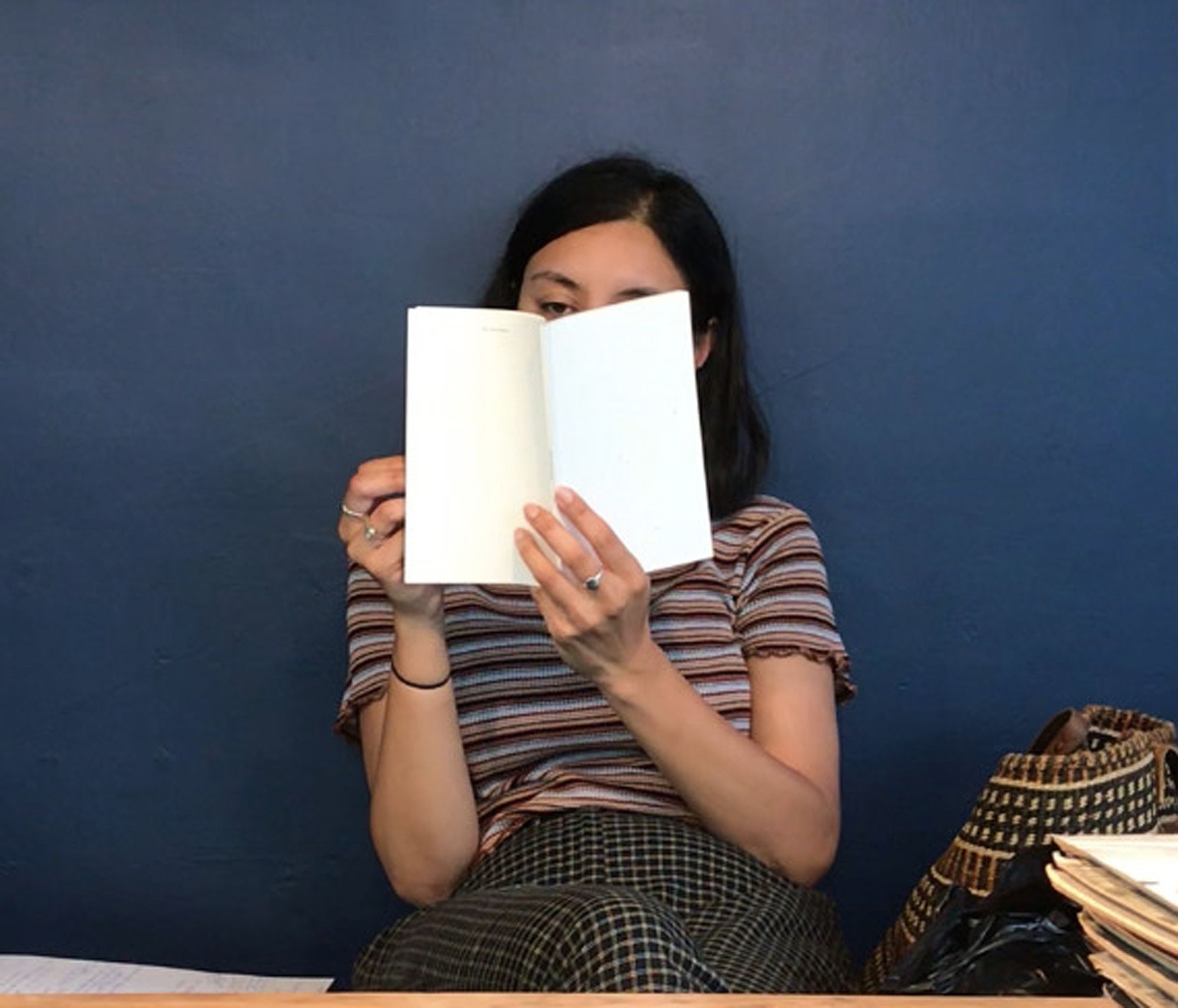Pushing Up the Skies: A Review of Speaking Surfaces
How do we make space for ourselves, and for each other? Huni Mancini reviews Speaking Surfaces at ST PAUL St.
In ancient Tonga it was believed there were many skies, like domes of increasing size stacked one upon another. Legend says the demigod Maui pushed up the skies to make space for himself and others to walk freely. In doing so he separated the heavens from our earthly realm. It was an act of heroic defiance but also one of agency.
What is it to speak? It can be a way of articulating oneself and expressing agency. It can be thought of as a reverberation, a spatial form that characterises the relationships between people and things in a given place and time.
There are many ways of speaking. We can speak across a distance or from nearby. We can come close to a subject without seizing or claiming it. The speaking can refer to the life around itself while at the same time having its own life.
Speaking Surfaces began as a design project for the AUT Spatial Design Year 3 Studio paper, in which students were invited to consider the colonial histories of galleries and museums and the way they can create spaces that no longer reinforce dominant power structures and narratives. During a year that marks AUT’s 20th anniversary, the resulting programme, hosted by ST PAUL St Gallery, is a chance to pause and reflect on these questions while also looking to the future.
*
How might a surface speak? The notion suggests that certain objects have agency, a life of their own.
Some Māori consider taonga to refer to objects both tangible and intangible that are imbued with mauri, a life force of their own. Taonga can also refer to objects that are the embodiment of living ancestors, for Moana people and cultures. In Christian belief, the spirited object might invoke the idea of demonic possession. Today, it might also reflect the possible sentience of artificial intelligence.
I sense refuge in the towering presence of VĀWĀ
In this sense, a ‘speaking surface’ relates to theories of immanence – the idea that God or the divine is manifested in the material world around us, rather than obtained by transcending reality.
The schedule of Speaking Surfaces follows the operating rhythm of the Maramataka, the Māori lunar calendar. The Maramataka has been used to guide planting, harvesting, fishing and hunting at different times of the year, the beginning of which is marked by Matariki, the Māori New Year. At various stages throughout the year new iterations of the programme have waxed and waned in the gallery space. Here the gallery is envisioned as a portal opening outwards, connecting students and staff with the public.
One resource I encountered mentions that “northern iwi have a saying: Nā Hina te pō, nā Hina te ao / Hina governs darkness and light, Hina governs life and death.”According to this legend, the moon is a portal between reality and creation that opens and closes as the moon waxes and wanes. Maui tried entering the portal to obtain immortality for humankind, but he was cut in two as the moon closed, leading humans to always be bound to death. In Tongan tradition the moon is also associated with Hina, whose figure is seen in its dark features, beating her ngatu while sitting under a fig tree.
A Moana concept of time and space known as tā-vā is also interwoven. Hūfanga ‘Ōkusitino Māhina describes tā-vā as a theory of reality where, “all things in nature, mind and society stand in eternal relations of exchange with one another.” In Tongan belief tā refers to time as “the beating of space”, literally meaning to beat, mark, form or perform. Vā is a concept known across Moana Oceania that refers to space. In Tonga, vā signifies a relational space fashioned through the relationship between time markers – beats, things or people.
VĀWĀ, by AUT Spatial Design graduate Sapati Mossiah Avei Fina‘i anchors the space. It references two types of vā found in Sāmoan tradition, Vā Fealoaloa‘i/the relational Vā and Vā Tapuia/the Vā in sacred spaces. There’s a sense of duality expressed by its two components. Made from macrocarpa and plywood respectively, they comprise upper and lower planes that trace the contours of the St Paul Street area. The space in between the platforms represents the vā; they remind me of Maui pushing up the sky, or Ranginui and Papatūānuku forced apart by Tāne, the god of forest and birds. I sense refuge in the towering presence of VĀWĀ, leaning against it and sitting on its built-in seating.Hugging the gallery’s central concrete pillar, it suggests an interdependence between institutional and Indigenous ways of knowing.
During the rāhui, time has seemed suspended in a feedback loop.
Placed on the lower plane of VĀWĀ is a collection of elemental sculptures, Calls herself into being (2020) by Ōtautahi artist Jen Bowmast (Pākeha). Made from cast bronze, glazed and fired clay, wax-dipped plant materials, water and carved wood, they sit on a circular obsidian plinth. These are materials that themselves go through transformational processes as they are formed. In proximity is her amorphous sculpture Psychopomp (2018). It resembles the philosopher’s stone in the process of becoming purified, matured and perfected.
Jen’s practice developed counter to the emphasis placed on predominantly European philosophy which she experienced during her studies in art. As a response to the academic focus on knowledge acquisition, she developed a more intuitive process of making that is grounded in metaphysical and spiritual inquiry. This includes consultation with psychic mediums, divinatory readers and scrying alongside philosophy and art theory. Consequently her works can be seen as “transitional objects located physically here and now while being connected to other places and times.” While standing on AUT campus grounds, they lead me to contemplate the esoteric legacy of Silicon Valley, birthplace of countless technologies that connect us across the vā.
By aligning activities with Indigenous concepts of time and space, Speaking Surfaces questions our dominant measure of time informed by the Gregorian calendar. It suggests an alternative to the encroachment of fast-capitalism on our lives and institutions: a gathering together in communion with objects and each other in the flesh. An invitation to observe and engage with the specificity of sites to better understand their “formal qualities, temperament and…atmosphere.”
Due to the complexities of Covid-19, a number of the iterations were not able to take place as planned, and an ability to engage with the site literally became restricted. The pandemic has fast become entangled in all our lives, disrupting our ability to flow as intended.
During the rāhui, time has seemed suspended in a feedback loop. We’ve been forced to move our productivity online while also moving inwards as we self-isolate. The importance of language has become evident. Reaching across our bubbles with a need to stay connected has led to a sense of being ‘always on’. And yet we’ve had more time to reflect and regenerate.
Jen Bowmast, Calling the Sentient, 2020
Vital connections are maintained at the speed of light by algorithms that compress time and space. Content appears on our timelines not chronologically but in relation to our data footprint. Multiple screens and interfaces connect and intersect us.
It’s in this way that I viewed much of Speaking Surfaces.Gaining access to the works through online portals, I began forming an idea of them prior to encountering them in person. I was taken by surprise when re-entering the space to find a new iteration disrupting the ideas I had formed in private.
Emerging from the second rāhui I found Gallery One to be engulfed in darkness, as if entering the dark reaches of the subconscious or the pause of a new moon. An uncanny new sculpture by Jen Bowmast, located in the same place upon the same obsidian plinth, is this time made of a giant divination tool perched on a coiled, dystopian cable. Attached is a globe of white pearls glowing under the projector lights.
Two video works, Quercus (2020) by Formafantasma and The Great Silence (2014) by Jennifer Allora and Guillermo Calzadilla with Ted Chiang, screen in alternation. They consider the human yearning for communication with non-human life and the use of technology to achieve it.
In Quercus we follow the imagined voice of an oak forest in an address to humankind as we traverse through their individual and collective anatomy using 3-D Lidar mapping technology. Lidar technology uses lasers to scan and record large surface areas and has often been used in cartography and archaeology. More recently, it has been adopted by the timber industry in order to selectively log trees. Voiced using text by botanist Emanuele Coccia, the work is described as both a map and a portrait. Lidar is repurposed to present an opportunity to connect with the intensely alive and intelligent life-force of trees and vegetal matter – what might be termed mauri in Aotearoa. An androgynous, android-like voice narrates:
I am a living being that can build hundreds of sexual organs. Consider that for us, reproduction is not a private and single-species activity. It is an ecological orgy, a concert of vegetal and animal beings co-operating in mating. The same is true for the self. I am not a being without self. I am a being whose self takes place in hundreds of parts of my body simultaneously. I am an organism that is plural, but not schizophrenic.
This sense of desire in abundance, as opposed to lacking an object. I consider the way the sexual revolution evolved alongside new perspectives of artificial intelligence proposed by the 1968 science fiction novel Do Androids Dream of Electric Sheep? The growing sentience of AI seems to mirror a growing apprehension that “it is easier to imagine the end of the world than an end to capitalism.”
Formafantasma, Quercus, 2020.
The Great Silence presents a flawed human conceptualisation of what it means to communicate, framed by The Fermi paradox, which in physics refers to the contradiction between a lack of evidence for extraterrestrial civilisations and the high estimates for their probability. Our gaze shifts between the dystopian Arecibo Observatory and the lush, meditative Puerto Rican jungle. Narrated by the imagined voice of an endangered parrot, Amazona vittata, it considers how in our grand scientific quest for communication we ignore the many possible connections with intelligent life available to us here and now.
Both works question colonialism’s treatment of flora and fauna as objects for exploitation, whose value lies only in their role as instruments of empire and civilisation.
In an unending quest to create ourselves anew, to transcend our current reality, what possibilities for meaning and connection do we ignore? How does this prove destructive for our evolutionary partners?
Encircling VĀWĀ, these films seem to take aim at design thinking. This phase of the exhibition therefore highlights the way the design process can be harnessed to enable a crucial shift in perspective that will aid protection of the natural environment, rather than further destroying it.
This idea stems from an understanding that humans and environment are inextricably interlinked. It resembles ways of life and knowing that Moana peoples have long structured their civilisations around. Colonial invasion, however, forced our communities to renounce their languages and belief systems. Therefore such a shift in perspective might simultaneously ask: How can space be created to enable a return to our ways of knowing?
*
Perhaps the vā between people and things can also be described as an object, with its own dimensions and sense of aliveness. Giovanni Bennardo, who has studied the cognitive representation of space in Tonga, describes vā as a space between two objects that is treated as if it were an object itself. Art historian Caroline Vercoe describes the diaspora as a place, a destination itself. She expands on writing by the late Epeli Hau’ofa, who provided a reconceptualisation of the Pacific in his influential essay Our Sea of Islands. Here he argues that Moana peoples were connected rather than separated by the sea.
How can space be created to enable a return to our ways of knowing?
Master of Visual Arts students Emily Parr (Ngāi Te Rangi, Pasifika, Pākehā) and Arielle Walker (Taranaki, Ngāruahine, Ngāpuhi, Pākehā) consider the discomfort of tracing their heritage through Western frameworks. In their video Whatuora (2020) the students depict themselves learning to weave while tracing their shared whakapapa to Kororāreka, Northland – a detail they were surprised to discover while sharing a studio space at AUT. With each braid they reflect on the passing down of knowledge, the repairing of ruptures, the bridging of time – a weaving together of different knowledge strands. Yet they acknowledge, “There is both tension and wonder in learning about oneself through museums and archives, which hold our ancestors’ taonga but rarely their voices. We must come to know our tūpuna wāhine in other ways.”
During the Matariki Master of Visual Art Graduate Show, student work by ‘Uhila Moe Langi Kanongata‘a Nai presents a continuum of ngatu/Tongan barkcloth and kupesi/ngatu pattern-making stencils from their own family archive. I recoil at the realisation this may be the first time I’ve seen the tools of ngatu-making up close, outside the walls of the vitrine.
Like VĀWĀ, this work expresses duality and is installed in two locations. The viewer must cross a threshold to view the work as a whole. We must reconcile the gulf between inside–outside. Even after this is done, there lingers a rupture of space and time that is made whole again through memory.
We are an amalgam of not only what we do but also what is done to us – a strange bodily entanglement. How do we address our own disorientations and entanglements, our selves as relationships, as space between?
*
This year Covid-19 has brought many of us down to the bone, exposing the infrastructure of our lives. In isolation we’ve been forced to rethink how we construct our daily routines. We’ve been asked to continually realign to a strange new environment when and where needed.
This isn’t new for Moana peoples. The arrival of Europeans brought diseases like tuberculosis, smallpox, measles and venereal infections that devastated populations. This loss of life also had a tremendous impact on cultural knowledge. Since the holders of knowledge are generally elders, their vulnerability to diseases meant they were dying at a rapid rate before being able to pass on their knowledge. In the years following Captain James Cook’s arrival, disease and slavery had decimated our populations by 75 to 98 percent in just over a century. A kind of apocalypse has already occurred for Moana peoples.
Emily Parr and Arielle Walker, Whatuora, 2020.
Nikau Hindin and Ben Thomason; Front: Jen Bowmast, Calls herself into being, 2020.
A number of works remind us how our ancestors continually adapted to the hostile new environments they found themselves in.
A vinyl star map by Nikau Hindin (Te Rarawa, Ngāpuhi) and Ben Thomason (Ngāti Raukawa ki te Tonga) in Gallery One is a two-dimensional visualisation of kāpehu whetū, Māori star compass, a conceptual framework for way-finding using currents, winds, waves and stars. Their map is a key to learning the names of our stars and where they rise and set on the horizon.
Nikau is known for revitalising the lost art of aute, Māori barkcloth, in which a star map is usually applied to form the patterned design. As a result of the aute plant’s near extinction in the 1840s there are few mentions of it in oral histories, and no definite examples of it in museums. Nikau’s combined practice creates a “new wave of ancient knowledge”, which recognises the importance of connecting, or reconnecting with the environment.,
In navigation, knowledge of the night sky was the most important of the mental constructs of knowledge needed for wayfinding. This extended to survival on land. The sighting of Matariki, for instance, was believed to carry tohu, or signs, predicting what would be encountered in the future. Knowledge of their meanings stemmed from observations made through the years.
Matariki connects us across tā-vā. Throughout Moana Oceania the constellation has been honoured as Mataliki in Tonga, Matali‘i in Samoa, Matari‘i in Tahiti, and Makali‘i in Hawai‘i. In the tropics Matariki was celebrated in November–December, but when the tūpuna came to Aotearoa they changed their celebrations to June, marking the time it first appears on the eastern horizon.
In Gallery Two there are two new works: Matariki Fetu‘u (2020), by Sione Monū, is suspended above Banig – Fala (2020), an unfolding mat work by Julia Mapusua, Sharon Semi-Tugia and Denise Jilian Saso. Matariki Fetu‘u can be thought of as a star map, a sculptural representation of the Matariki open star cluster. I count nine stars – the number observed by some iwi – as opposed to seven indicated by the Seven Sisters of Greek mythology. Sione’s stars are part of a continued experimentation with nimamea‘a tuikakala, the Tongan fine art of flower design used for making kahoa/garlands. The divine constellation is here enshrined with the artist’s signature use of bright plastic flowers and beads collected from Māngere and Ōtara township dollar stores.
Sione Monu, Matariki fetu’u, 2020.
They overhang Banig – Fala, an interactive design project that creates space for people to gather as they weave a banig/fala (mat) made from large strips of pine. The mat has been partially completed and is to be continually woven by anyone visiting the space using spare pine strips provided at the entrance.
Together these works represent the rhizomatic migration of Oceanic peoples, whose continual movements have formed a network of connection throughout the ages. Yet in the quest for new terrain there remains a desire to hold on to previous ways of knowing. The durability of both artists’ materials suggests a necessity for forms of remembering that can withstand the frequent winds of change.
Finally, what could this become? (2020) by Xin Cheng and Monique Jansen touches on the act of collecting. Using foraged ‘waste’ from around AUT, the artists improvise a host of materials in the process of building up an ad-hoc collection.
The result is a reminder that we are not only what we choose to keep, but also what we discard. Their improvised sculptures each contain the mysteries of the universe; a record and celebration for all the matter we edit out of our carefully curated collections. I am amused reading their list of materials, which includes “Instant coffee that keeps getting delivered despite no one drinking it, from the Visual Arts staff office.”
Xin Cheng and Monique Jansen, what could this become?, 2020.
Future horizons
Our navigational tools are a beacon in the midst of a lost horizon of futures caused by the cultural logic of postmodernism, totalising in its wake.
In the time–space compression of late capitalism, “time horizons shorten to the point where the present is all there is.” Technology and commodity compress time in order to increase economic efficiency, leading to an erosion of boundaries that denies us private space and time.
In our current epoch the future is less about temporality and more a structure of feeling; a certain style affiliated with a certain affect. By dwelling in surfaces of sublime, we’ve created a world without a fixed horizon. It’s a world that’s terrifying because it’s asking us to reflect on our own shifting proximity to depth and oblivion.
Speaking Surfaces reconciles AUT’s global, technological focus with the need for grounding in time and place specific to Tāmaki Makaurau, Aotearoa and wider Te Moana-Nui-a-Kiwa. It’s an invitation to find balance between the energy we invest in ourselves and in others.
As I commune with the objects in the space both real and imagined, a series of questions come into form.
How do we continue to make space for ourselves and each other? How do we enable and multiply worlds, rather than interpret others’ worlds on their behalf? How might our infrastructure connect with the very tikanga of this place beyond the user interface, embedding it as we might in our very leadership? I settle on the notion that any less is simulacrum.
Speaking Surfaces
St Paul St
28 Feb 2020 - 4 Dec 2020
Feature image (top of page): Sione Monu, Matariki fetu'u, 2020. All images by Sam Hartnett and courtesy of St Paul St unless otherwise stated.
This piece is presented as part of a partnership with St Paul St gallery, which covers the costs of paying our writers while we retain all editorial control.
